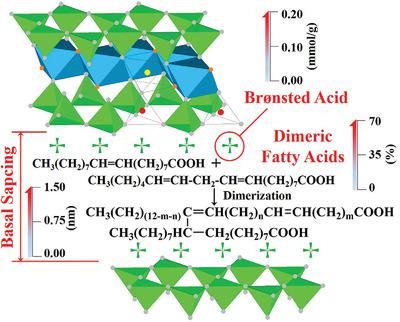当前位置:
X-MOL 学术
›
Eur. J. Lipid Sci. Technol.
›
论文详情
Our official English website, www.x-mol.net, welcomes your feedback! (Note: you will need to create a separate account there.)
Improving the Stability and Efficiency of Dimeric Fatty Acids Production by Increasing the Brønsted Acidity and Basal Spacing of Montmorillonite
European Journal of Lipid Science and Technology ( IF 2.7 ) Pub Date : 2020-02-12 , DOI: 10.1002/ejlt.201900342 Zhihe Wang 1 , Xianghong Lu 1 , Xiao Liang 1 , Jianbing Ji 1
European Journal of Lipid Science and Technology ( IF 2.7 ) Pub Date : 2020-02-12 , DOI: 10.1002/ejlt.201900342 Zhihe Wang 1 , Xianghong Lu 1 , Xiao Liang 1 , Jianbing Ji 1
Affiliation

|
Montmorillonite (MMT) is widely used as the catalyst in the commercial production of dimeric fatty acids (DAs). However, the dimerization activity of MMTs from different mineral sources is usually different, leading to unstable yield of DAs. In order to obtain a high and stable yield of DAs, the relationship between the dimerization activity and characteristics of MMT should be clarified. The characteristics of seven MMTs from different mineral sources, including the acidity (the type, strength, and amount of the acid sites), composition (interlayer cations, Si/Al ratio, water content, pH), and structure (basal spacing) are determined and correlated with their dimerization activity. Additionally, the relationship between dimerization activity and characteristics of MMT is quantified by nonlinear‐regression. It is found that the dimerization activity of MMT is mainly influenced by its Bronsted acidity and basal spacing. Stable DA yield of around 70% on MMT is obtained at the amount of weak Bronsted acid sites of more than 0.20 mmol g⁻¹ and basal spacing of larger than 1.50 nm. Additionally, it is found that acid treatment is an effective method to adjust the Bronsted acidity and basal spacing of MMT. Practical Applications: The positive effect of Bronsted acid sites amount and basal spacing on the activity of MMT has practical value on the selection of highly efficient MMT catalyst for DA production. In addition, some MMT with poor activity can be activated by the acid treatment method mentioned in the paper.
中文翻译:

通过增加蒙脱石的布朗斯台德酸度和基础间距来提高二聚脂肪酸生产的稳定性和效率
蒙脱石 (MMT) 被广泛用作二聚脂肪酸 (DA) 商业生产中的催化剂。然而,不同矿物来源的 MMTs 的二聚活性通常不同,导致 DAs 的产量不稳定。为了获得高且稳定的DAs,应明确二聚化活性与MMT特性之间的关系。来自不同矿物来源的七种 MMT 的特征,包括酸度(酸位的类型、强度和数量)、组成(层间阳离子、Si/Al 比、含水量、pH)和结构(基础间距)是确定并与它们的二聚化活性相关。此外,二聚化活性与 MMT 特性之间的关系通过非线性回归进行量化。发现MMT的二聚活性主要受其布朗斯台德酸度和基础间距的影响。在弱布朗斯台德酸位点的数量超过 0.20 mmol g⁻¹ 且基础间距大于 1.50 nm 时,MMT 上的稳定 DA 产率约为 70%。此外,还发现酸处理是调节 MMT 的布朗斯台德酸度和基础间距的有效方法。实际应用:布朗斯台德酸位点数量和基础间距对MMT活性的积极影响对于选择高效的MMT催化剂生产DA具有实用价值。此外,一些活性较差的MMT可以通过论文中提到的酸处理方法进行活化。在弱布朗斯台德酸位点的数量超过 0.20 mmol g⁻¹ 且基础间距大于 1.50 nm 时,MMT 上的稳定 DA 产率约为 70%。此外,还发现酸处理是调节 MMT 的布朗斯台德酸度和基础间距的有效方法。实际应用:布朗斯台德酸位点数量和基础间距对MMT活性的积极影响对于选择高效的MMT催化剂生产DA具有实用价值。此外,一些活性较差的MMT可以通过论文中提到的酸处理方法进行活化。在弱布朗斯台德酸位点的数量超过 0.20 mmol g⁻¹ 且基础间距大于 1.50 nm 时,MMT 上的稳定 DA 产率约为 70%。此外,还发现酸处理是调节 MMT 的布朗斯台德酸度和基础间距的有效方法。实际应用:布朗斯台德酸位点数量和基础间距对MMT活性的积极影响对于选择高效的MMT催化剂生产DA具有实用价值。此外,一些活性较差的MMT可以通过论文中提到的酸处理方法进行活化。布朗斯台德酸位点数量和基础间距对 MMT 活性的积极影响对于选择高效的 MMT 催化剂用于 DA 生产具有实用价值。此外,一些活性较差的MMT可以通过论文中提到的酸处理方法进行活化。布朗斯台德酸位点数量和基础间距对 MMT 活性的积极影响对于选择高效的 MMT 催化剂用于 DA 生产具有实用价值。此外,一些活性较差的MMT可以通过论文中提到的酸处理方法进行活化。
更新日期:2020-02-12
中文翻译:

通过增加蒙脱石的布朗斯台德酸度和基础间距来提高二聚脂肪酸生产的稳定性和效率
蒙脱石 (MMT) 被广泛用作二聚脂肪酸 (DA) 商业生产中的催化剂。然而,不同矿物来源的 MMTs 的二聚活性通常不同,导致 DAs 的产量不稳定。为了获得高且稳定的DAs,应明确二聚化活性与MMT特性之间的关系。来自不同矿物来源的七种 MMT 的特征,包括酸度(酸位的类型、强度和数量)、组成(层间阳离子、Si/Al 比、含水量、pH)和结构(基础间距)是确定并与它们的二聚化活性相关。此外,二聚化活性与 MMT 特性之间的关系通过非线性回归进行量化。发现MMT的二聚活性主要受其布朗斯台德酸度和基础间距的影响。在弱布朗斯台德酸位点的数量超过 0.20 mmol g⁻¹ 且基础间距大于 1.50 nm 时,MMT 上的稳定 DA 产率约为 70%。此外,还发现酸处理是调节 MMT 的布朗斯台德酸度和基础间距的有效方法。实际应用:布朗斯台德酸位点数量和基础间距对MMT活性的积极影响对于选择高效的MMT催化剂生产DA具有实用价值。此外,一些活性较差的MMT可以通过论文中提到的酸处理方法进行活化。在弱布朗斯台德酸位点的数量超过 0.20 mmol g⁻¹ 且基础间距大于 1.50 nm 时,MMT 上的稳定 DA 产率约为 70%。此外,还发现酸处理是调节 MMT 的布朗斯台德酸度和基础间距的有效方法。实际应用:布朗斯台德酸位点数量和基础间距对MMT活性的积极影响对于选择高效的MMT催化剂生产DA具有实用价值。此外,一些活性较差的MMT可以通过论文中提到的酸处理方法进行活化。在弱布朗斯台德酸位点的数量超过 0.20 mmol g⁻¹ 且基础间距大于 1.50 nm 时,MMT 上的稳定 DA 产率约为 70%。此外,还发现酸处理是调节 MMT 的布朗斯台德酸度和基础间距的有效方法。实际应用:布朗斯台德酸位点数量和基础间距对MMT活性的积极影响对于选择高效的MMT催化剂生产DA具有实用价值。此外,一些活性较差的MMT可以通过论文中提到的酸处理方法进行活化。布朗斯台德酸位点数量和基础间距对 MMT 活性的积极影响对于选择高效的 MMT 催化剂用于 DA 生产具有实用价值。此外,一些活性较差的MMT可以通过论文中提到的酸处理方法进行活化。布朗斯台德酸位点数量和基础间距对 MMT 活性的积极影响对于选择高效的 MMT 催化剂用于 DA 生产具有实用价值。此外,一些活性较差的MMT可以通过论文中提到的酸处理方法进行活化。



























 京公网安备 11010802027423号
京公网安备 11010802027423号